The All-in-One TOGAF Guide
Introduction to TOGAF
In the ever-evolving landscape of enterprise architecture frameworks, TOGAF® (The Open Group Architecture Framework) stands as a resilient and enduring framework that has been serving the technology industry for nearly two decades. Developed by The Open Group, a not-for-profit technology industry consortium, TOGAF® continues to evolve to meet the dynamic demands of the technology landscape.

This comprehensive guide will walk you through the essentials of TOGAF®, making it accessible to beginners and offering a holistic view of this powerful framework. Here’s a breakdown of what we’ll cover:
Understanding Enterprise Architecture
What is Enterprise Architecture?
Enterprise Architecture (EA) is a strategic framework and holistic approach that organizations use to effectively align their business processes, information systems, technology infrastructure, and human resources with their overall goals and objectives. It provides a structured way to manage and optimize an organization’s assets and capabilities in order to achieve its desired outcomes.
At its core, Enterprise Architecture seeks to answer critical questions about how an organization operates, such as:
- What is the organization’s current state? This involves understanding the existing processes, systems, data, and technology in use.
- What is the desired future state? What goals and objectives does the organization want to achieve in the long run?
- How can the organization bridge the gap between the current state and the future state? What changes, improvements, or transformations are necessary?
- How can the organization ensure that its IT investments and strategies are aligned with its business goals?
- How can the organization optimize its resources and reduce inefficiencies?
In essence, Enterprise Architecture provides a blueprint for how an organization should operate across various domains, including business, data, applications, and technology, to drive efficiency, agility, and competitiveness.
The Goals of Enterprise Architecture
The primary goals of Enterprise Architecture can be summarized as follows:
- Alignment: Ensure that an organization’s business strategy, goals, and processes are aligned with its IT infrastructure and technology solutions. This alignment ensures that technology investments support the organization’s objectives.
- Efficiency: Identify opportunities to streamline business processes, reduce redundancy, and eliminate inefficiencies. This leads to cost savings and improved resource utilization.
- Agility: Enable the organization to adapt quickly to changing business environments and emerging technologies. This includes the ability to respond to market shifts, customer demands, and competitive pressures.
- Standardization: Establish and enforce standards, best practices, and guidelines for technology adoption and development. Standardization simplifies maintenance, integration, and interoperability across the organization.
- Risk Management: Identify and mitigate risks related to technology, data, security, and compliance. Enterprise Architecture helps ensure that the organization is resilient and can respond effectively to threats and challenges.
- Innovation: Foster innovation by providing a structured framework for evaluating and implementing new technologies and solutions that can drive business growth and competitive advantage.
- Transparency: Enhance communication and collaboration across all levels of the organization. Enterprise Architecture provides a common language and visualization of complex concepts, making it easier for stakeholders to understand and contribute to decision-making.
- Cost Optimization: Identify opportunities to reduce IT costs while maintaining or improving service quality. This involves rationalizing applications, optimizing infrastructure, and making informed investment decisions.
- Long-term Planning: Develop a strategic roadmap that guides the organization’s technology investments and initiatives over time. This helps ensure that short-term decisions align with long-term objectives.
Enterprise Architecture is a strategic discipline that helps organizations achieve their objectives by aligning business and technology, optimizing operations, managing risks, and fostering innovation. Its ultimate goal is to enhance the organization’s ability to thrive in a rapidly evolving business landscape.
Architecture Domains in TOGAF
TOGAF® (The Open Group Architecture Framework) divides the enterprise architecture into several key domains, each with its specific focus and objectives. These domains provide a structured framework for understanding and designing different aspects of an organization’s architecture. Here are the core architecture domains in TOGAF:
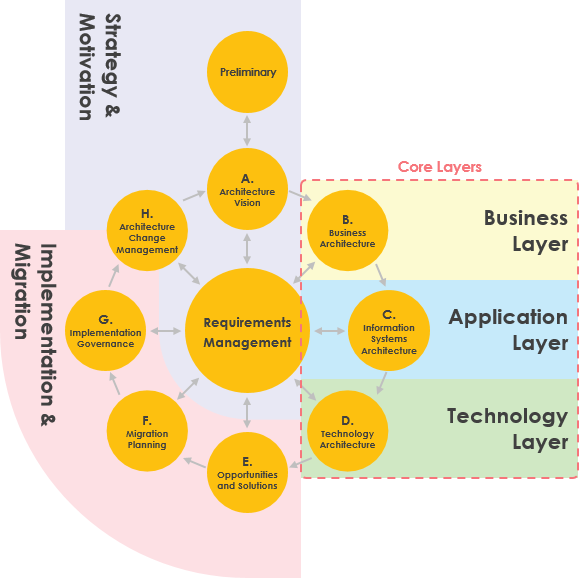
1. Business Architecture
Definition: Business Architecture defines the fundamental structure and operation of an organization’s business. It focuses on understanding the organization’s strategy, governance, organizational structure, key business processes, and how they interact.
Objectives:
- Define the organization’s business strategy and goals.
- Describe the organization’s governance structure and decision-making processes.
- Identify and document key business processes and workflows.
- Analyze the relationships between different business units and functions.
- Align business objectives with IT initiatives and capabilities.
2. Data Architecture
Definition: Data Architecture deals with the structure, organization, and management of an organization’s data assets. It includes defining data models, data standards, data storage, data flows, and data governance.
Objectives:
- Design and document data models and databases.
- Establish data standards and data management practices.
- Ensure data quality, security, and compliance.
- Define data integration and data sharing mechanisms.
- Support business decision-making through data analysis and reporting.
3. Application Architecture
Definition: Application Architecture focuses on the design and structure of individual application systems within the organization. It includes defining application components, interfaces, and their interactions.
Objectives:
- Identify and document application components and modules.
- Define application interfaces and integration points.
- Ensure that applications align with business processes.
- Support scalability and performance of applications.
- Evaluate and select appropriate application technologies and platforms.
4. Technology Architecture
Definition: Technology Architecture describes the hardware, software, networks, and infrastructure required to support an organization’s IT environment. It includes defining technology standards, platforms, and infrastructure components.
Objectives:
- Specify the technology stack and infrastructure components.
- Define hardware and software standards.
- Ensure data security, availability, and disaster recovery.
- Support the deployment and operation of application systems.
- Evaluate emerging technologies for potential adoption.
5. Expanding Horizons in Enterprise Architecture
Enterprise Architecture is a dynamic field that evolves to meet the changing needs of organizations. While the core architecture domains mentioned above are fundamental, modern enterprise architecture has expanded to address additional business needs and challenges. These expanding horizons include:
- Business Process Management: Emphasizes the modeling, analysis, and optimization of business processes to enhance efficiency and agility.
- Data Analytics and Big Data: Focuses on leveraging data analytics and big data technologies to gain insights and make data-driven decisions.
- Cloud Computing: Addresses the adoption of cloud services and the integration of cloud solutions into the enterprise architecture.
- Security Architecture: Ensures that security measures and practices are integrated into all aspects of the architecture to protect against cyber threats and data breaches.
- Digital Transformation: Supports the organization’s efforts to transform digitally, including the adoption of emerging technologies like IoT, AI, and blockchain.
- Customer Experience (CX) Architecture: Concentrates on delivering exceptional customer experiences through technology and process enhancements.
- Sustainability and Environmental Considerations: Incorporates sustainable practices into the architecture to reduce the organization’s environmental footprint.
As organizations face new challenges and opportunities, Enterprise Architecture continues to evolve to address these expanding horizons, helping organizations stay competitive and innovative in a rapidly changing business landscape.
TOGAF History and Facts
Evolution of Enterprise Architecture
The field of Enterprise Architecture (EA) traces its roots back to the mid-1960s when organizations, particularly in the context of computing and information technology, began recognizing the need for structured approaches to managing complex systems. IBM and other companies and universities pioneered early efforts to develop systematic methods for designing and managing enterprise architectures.
Over the decades, as technology evolved and businesses became increasingly reliant on information systems, the need for a formalized framework for enterprise architecture became more apparent. Enterprise architecture started to gain recognition as a discipline that could help organizations navigate the complexities of IT and align technology with business objectives.
The Emergence of TOGAF®
TOGAF, or The Open Group Architecture Framework, made its debut in 1995 as a response to the growing demand for a comprehensive and standardized approach to enterprise architecture. TOGAF was developed by The Open Group, a not-for-profit technology industry consortium dedicated to promoting open standards and best practices in information technology.
The development of TOGAF was influenced by the recognition that there was a need for a globally recognized and vendor-neutral framework that could provide guidance to organizations in developing and implementing their enterprise architectures. TOGAF was designed to be adaptable, scalable, and compatible with various industries and sectors.
Interestingly, TOGAF drew inspiration from the U.S. Department of Defense’s own Enterprise Architecture Framework, known as the Technical Architecture Framework for Information Management (TAFIM). While TAFIM was used by the U.S. DoD for a brief period, TOGAF continued to evolve and gain widespread adoption globally.
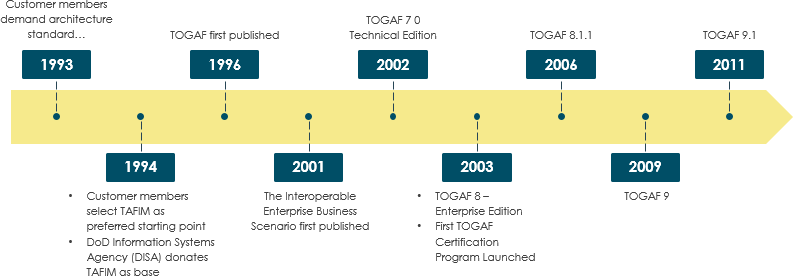
TOGAF’s Global Impact
Today, TOGAF has become the de facto global standard for enterprise architecture. Its impact is evident in numerous ways:
- Global Adoption: TOGAF is employed by a vast number of organizations worldwide. According to The Open Group, it is used in more than 80 percent of Global 50 companies and over 60 percent of Fortune 500 companies.
- Consistency and Standardization: TOGAF provides a common framework and vocabulary for enterprise architecture, promoting consistency and standardization in the field. This helps organizations communicate effectively and collaborate on architectural projects.
- Vendor-Neutral: TOGAF is vendor-neutral, meaning it does not promote or require specific technologies or products. This neutrality allows organizations to choose the technologies that best suit their needs while following TOGAF principles.
- Continuous Evolution: TOGAF is not static; it evolves over time to keep pace with changing technology landscapes and emerging best practices. New versions and updates are released to ensure its relevance and effectiveness.
- Certification Programs: The Open Group offers certification programs for individuals and tools that align with TOGAF. These certifications validate the knowledge and skills of architects and the compatibility of tools with the framework.
- Community and Collaboration: TOGAF has a vibrant community of practitioners, architects, and organizations that contribute to its development and share insights and experiences. This collaborative spirit strengthens the framework’s value.
TOGAF’s history reflects the evolution of enterprise architecture as a discipline, and its global impact is evident in its widespread adoption and the benefits it brings to organizations seeking to manage and optimize their enterprise architectures.
Architecture Development Method (ADM)
The Architecture Development Method (ADM) is a core component of TOGAF (The Open Group Architecture Framework). It is a structured approach that guides organizations in the creation, evolution, and management of their enterprise architectures. ADM consists of several phases and steps that help architects develop and implement architectures that align with business goals and objectives. Here are the key phases within the ADM:
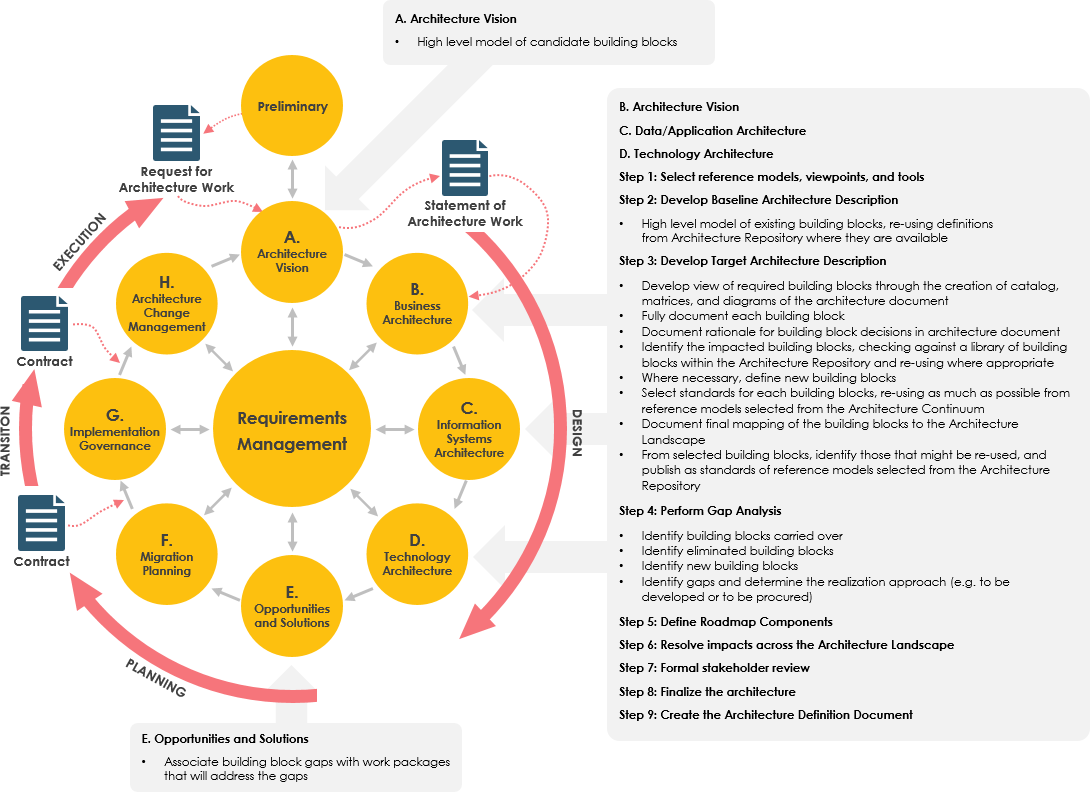
1. Preliminary Phase
Objective: The Preliminary Phase lays the groundwork for the architecture development process. It includes activities such as setting up an architecture framework, defining principles, and preparing to meet the business directive for new enterprise architecture.
2. Phase A: Architecture Vision
Objective: In this phase, architects define the initial vision of the enterprise architecture. They identify the scope, stakeholders, and business drivers, and create the Architecture Vision document. This phase aims to gain approval and support for the architecture development process.
3. Phase B: Business Architecture
Objective: Business Architecture focuses on understanding and documenting the organization’s business strategy, key business processes, organizational structure, and governance. Architects create the Business Architecture document, which serves as a blueprint for aligning IT with business needs.
4. Phase C: Information Systems Architectures
Objective: Information Systems Architectures involve designing the architecture for individual application systems. This phase includes developing Data Architecture and Application Architecture to support the Business Architecture. Architects create architecture building blocks and document the relationships between them.
5. Phase D: Technology Architecture
Objective: Technology Architecture defines the technology infrastructure required to support the deployment of application systems. This phase includes specifying hardware, software, networks, and other technology components. It ensures that the technology aligns with the organization’s business goals.
6. Phase E: Opportunities & Solutions
Objective: In this phase, architects assess the gaps between the current architecture and the desired future state. They identify opportunities for improvement and develop a set of solution options. The result is an Implementation and Migration Plan that outlines how to transition to the target architecture.
7. Phase F: Migration Planning
Objective: Migration Planning involves creating a detailed plan for implementing the architecture changes identified in the previous phases. This plan includes defining transition architectures and selecting appropriate migration projects. It ensures a smooth transition to the target architecture.
8. Phase G: Implementation Governance
Objective: Implementation Governance focuses on ensuring that the architecture is implemented correctly and that it aligns with the defined standards and principles. It includes monitoring and controlling the implementation projects to mitigate risks and ensure compliance.
9. Phase H: Architecture Change Management
Objective: Architecture Change Management establishes procedures for managing changes to the new architecture. It includes managing change requests, assessing their impact, and making informed decisions about whether to approve or reject them. This phase ensures that the architecture remains stable and effective.
10. Requirements Management
Objective: Requirements Management examines the process of managing architecture requirements throughout the ADM. It involves capturing, analyzing, and prioritizing stakeholder requirements and ensuring that the architecture aligns with these requirements throughout its development and evolution.
Each of these ADM phases plays a crucial role in the development and evolution of enterprise architectures. They provide a structured approach for architects to follow, ensuring that the resulting architecture is well-aligned with the organization’s goals, scalable, and capable of adapting to changes in the business environment.
Deliverables, Artifacts, and Building Blocks
In TOGAF (The Open Group Architecture Framework), deliverables, artifacts, and building blocks are essential components used to describe and document various aspects of the enterprise architecture. They play a crucial role in defining, communicating, and implementing the architecture effectively. Let’s explore these concepts:
Understanding TOGAF Deliverables
Deliverables in TOGAF are work products or documentation produced during the architecture development process. They provide a clear and structured way to communicate architectural information to stakeholders. Deliverables are typically associated with specific phases of the Architecture Development Method (ADM). Some common TOGAF deliverables include:
- Architecture Vision: A deliverable in the Architecture Vision phase that describes the high-level goals, objectives, and key drivers for the architecture project.
- Business Architecture Document: Produced in the Business Architecture phase, it describes the organization’s business strategy, key business processes, and organizational structure.
- Data Architecture Document: Created in the Information Systems Architectures phase, it defines the logical and physical data assets, data management resources, and data models.
- Application Architecture Document: Developed in the Information Systems Architectures phase, it outlines the structure of individual application systems, including components, interfaces, and relationships.
- Technology Architecture Document: Generated in the Technology Architecture phase, it describes the technology stack, infrastructure, standards, and hardware/software configurations.
- Implementation and Migration Plan: Part of the Opportunities & Solutions phase, it outlines the strategy for transitioning from the current state architecture to the target state architecture.
- Architecture Roadmap: A high-level document created in the Opportunities & Solutions phase that provides a timeline for executing the architecture changes.
- Architecture Contract: Produced in the Implementation Governance phase, it defines the agreements and expectations between architecture development teams and implementation teams.
- Architecture Repository: A central repository that stores and manages architectural artifacts, building blocks, and other architecture-related information.
These are just a few examples of TOGAF deliverables. The choice of deliverables may vary depending on the organization’s needs and the specific architecture project.
Architectural Artifacts
Architectural artifacts are detailed documentation, models, diagrams, and other representations that provide deeper insights into the architecture. They are created as part of the architecture development process and are often associated with specific deliverables. Some common architectural artifacts in TOGAF include:
- Architecture Models: These include various models such as business process models, data models, application models, and technology models. They represent different aspects of the architecture.
- Diagrams: Diagrams like data flow diagrams, network diagrams, and component diagrams help visualize architectural concepts and relationships.
- Matrices: Matrices, such as data matrices and interface matrices, show relationships and dependencies between architectural components.
- Business Scenarios: Detailed scenarios that describe how the architecture supports specific business processes and objectives.
- Use Cases: Use cases illustrate how users interact with the system and how it responds to their actions.
- Requirements Documents: These specify architectural requirements and constraints that must be considered during architecture development.
- Standards and Guidelines: Documentation of architectural standards, design guidelines, and best practices for consistency and quality.
Building Blocks in Enterprise Architecture
Building blocks are fundamental components or modules used to construct the architecture. They represent the smallest units of architecture that can be combined to create larger systems or solutions. Building blocks can be at various levels of abstraction and may include software components, hardware devices, data structures, and more. In TOGAF, building blocks are classified into two main categories:
- Architecture Building Blocks (ABBs): These are building blocks that represent potentially reusable components of the business. ABBs describe capabilities needed to support the organization’s architecture, such as processes, data, and application software.
- Solution Building Blocks (SBBs): SBBs are building blocks used to implement specific solutions. They are created based on ABBs and represent components like hardware, software, and services required for a particular solution.
Building blocks provide a way to standardize and modularize the architecture, making it more adaptable and easier to manage. They are the building materials that architects use to construct the enterprise architecture, and their proper definition and documentation are crucial for architecture design and implementation.
In summary, TOGAF emphasizes the importance of deliverables, artifacts, and building blocks in the architecture development process. These components help architects communicate, plan, and execute the architecture effectively, ensuring that it aligns with business goals and objectives.
Enterprise Continuum
In TOGAF (The Open Group Architecture Framework), the Enterprise Continuum and Architecture Repository are two important concepts that play a significant role in the development and management of enterprise architectures.
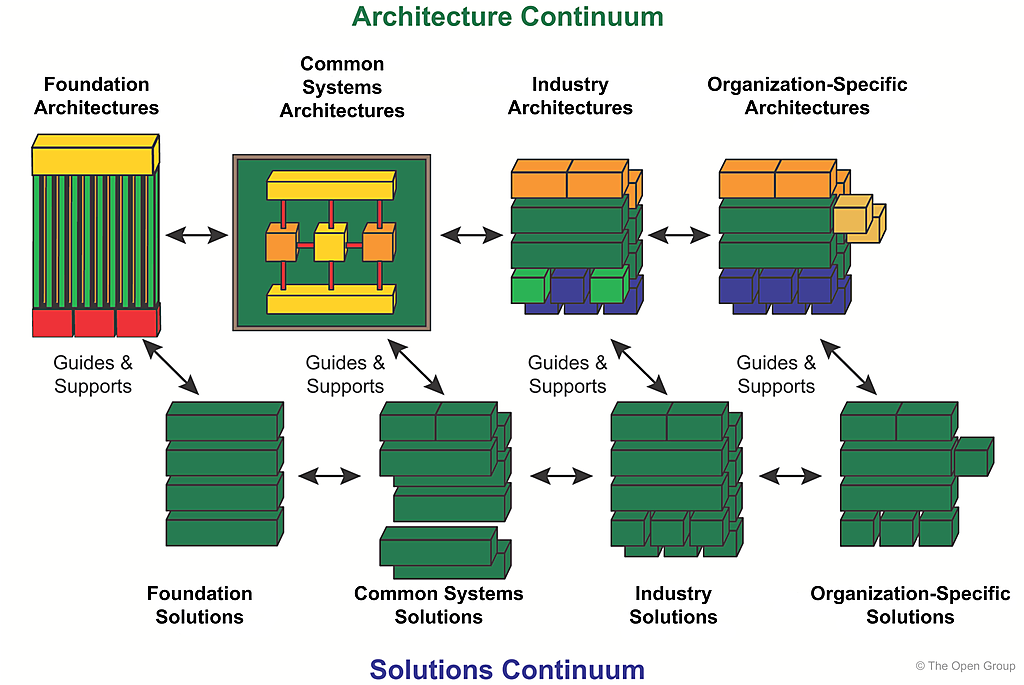
Enterprise Continuum
The Enterprise Continuum is a concept in TOGAF that provides a framework for classifying and organizing architectural assets and artifacts within the organization. It helps architects understand where a particular architecture asset fits in the broader context and how it evolves over time. The Enterprise Continuum comprises two complementary concepts:
-
Architecture Continuum: The Architecture Continuum represents the evolution of architectural assets from generic, industry-standard solutions to more organization-specific solutions. It provides a way to categorize architecture assets along a continuum, starting with common, widely accepted solutions and progressing toward more customized and organization-specific solutions. The continuum includes the following categories:
- Foundation Architectures: Generic, industry-standard solutions that serve as the basis for architecture development.
- Common Systems Architectures: Solutions that are still relatively generic but may be tailored to some extent to meet specific organizational needs.
- Industry Architectures: Solutions that align with industry-specific standards and best practices.
- Organization-Specific Architectures: Highly customized solutions that reflect the unique requirements and strategies of the organization.
- Solutions Continuum: The Solutions Continuum represents the actual instances of architecture assets that are used or planned within the organization. It includes specific implementations, projects, and architectures that are derived from the architecture assets defined in the Architecture Continuum. This continuum helps organizations manage and track the use of architecture assets in various projects and initiatives.
The Enterprise Continuum is a valuable tool for architects because it allows them to leverage existing architecture assets and knowledge, promotes reuse, and ensures that architectural solutions align with industry standards and organizational goals. It provides a structured approach to managing the organization’s architectural assets throughout their lifecycle.
Architecture Repository
The Architecture Repository is a central repository of architecture-related information and assets that supports the architecture development process. It is a key component of the TOGAF Architecture Repository is a vital resource for architects and other stakeholders involved in architecture development. The Architecture Repository includes various components:
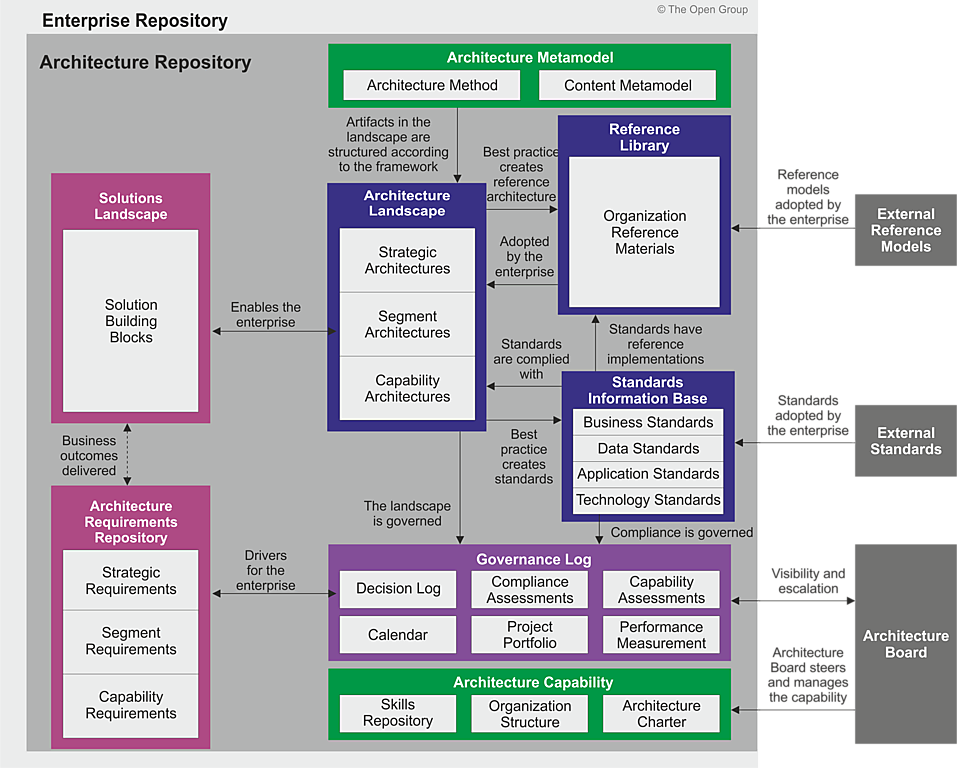
- Architecture Metamodel: This component defines the organization-specific application of an architecture framework, including the metamodel for architecture content. It provides a structured way to model and organize architecture-related information.
- Architecture Capability: The Architecture Capability component defines the parameters, structures, and processes that support the governance of the Architecture Repository. It includes roles, responsibilities, and processes for managing and maintaining architecture assets.
- Architecture Landscape: This component provides an architectural view of the building blocks that are currently in use within the organization. It includes a list of live applications, systems, and other architectural assets. The landscape may exist at multiple levels of abstraction to serve different architecture objectives.
- Standards Information Base (SIB): The SIB captures information about the standards and guidelines that architecture assets must comply with. It includes industry standards, selected products and services from suppliers, and shared services already deployed within the organization.
- Reference Library: The Reference Library contains guidelines, templates, patterns, and other forms of reference material that can be leveraged to accelerate the creation of new architectures. It serves as a knowledge repository for architects.
- Governance Log: The Governance Log provides a record of governance activities related to architecture development and management. It tracks decisions, approvals, and changes made throughout the architecture lifecycle.
The Architecture Repository serves as a central, well-organized storehouse of architecture assets and information. It facilitates collaboration among architects and other stakeholders by providing easy access to relevant data, standards, and reference materials. Architects can leverage the Repository to ensure consistency, reuse best practices, and support decision-making throughout the architecture development process.
The Enterprise Continuum and Architecture Repository are essential components of TOGAF that help organizations manage, classify, and leverage architecture assets and information effectively. They promote the reuse of best practices, ensure alignment with organizational goals, and support the development and maintenance of high-quality enterprise architectures.
Architecture Repository
The Architecture Repository is a central component in TOGAF (The Open Group Architecture Framework) that serves as a repository for architectural assets and information. It plays a crucial role in managing, storing, and organizing various artifacts, documents, and resources related to enterprise architecture. Let’s delve into the components of an Architecture Repository and how it enables organizations to leverage resources for organization-specific architecture.
Components of an Architecture Repository
An Architecture Repository typically consists of several key components that collectively provide a structured and organized environment for managing architectural assets and information. These components include:
- Architecture Metamodel: This component defines how architectural information is structured and organized within the repository. It includes concepts, relationships, and attributes that allow architects to model and represent architecture assets effectively. The metamodel ensures consistency in how architecture information is stored and accessed.
- Architecture Capability: The Architecture Capability component outlines the processes, roles, responsibilities, and workflows associated with the governance and management of architectural assets. It defines how architecture-related activities are carried out within the organization, ensuring that best practices and standards are followed.
- Architecture Landscape: This component provides an architectural view of the current state of the organization’s architecture. It includes a catalog of existing architectural assets, such as applications, systems, data models, and infrastructure components. The landscape helps architects understand the organization’s existing architecture and its dependencies.
- Standards Information Base (SIB): The SIB captures information about relevant standards, guidelines, regulations, and best practices that architecture assets must adhere to. It helps ensure that architectural solutions align with industry standards and compliance requirements.
- Reference Library: The Reference Library contains a collection of guidelines, templates, patterns, and reference materials that support architecture development. Architects can leverage these resources to accelerate the creation of new architectures and ensure consistency in design and implementation.
- Governance Log: The Governance Log maintains a record of governance activities related to architecture development and management. It tracks decisions, approvals, reviews, and changes made throughout the architecture lifecycle. The log provides transparency and accountability in the governance process.
Leveraging Resources for Organization-Specific Architecture
The Architecture Repository plays a crucial role in helping organizations leverage resources for developing organization-specific architectures. Here’s how it facilitates this process:
- Reuse of Best Practices: The Reference Library within the Architecture Repository contains a wealth of best practices, templates, and design patterns. Architects can leverage these resources to adopt industry-standard solutions and proven design principles when creating organization-specific architectures. This reuse of best practices accelerates architecture development and ensures high-quality outcomes.
- Standards Compliance: The SIB component ensures that organization-specific architectures comply with relevant industry standards, regulations, and guidelines. Architects can reference the standards information to design architectures that meet compliance requirements and adhere to established industry norms.
- Knowledge Sharing: The Architecture Repository serves as a knowledge-sharing platform where architects and stakeholders can access architectural artifacts, documentation, and reference materials. This knowledge sharing fosters collaboration, reduces duplication of effort, and promotes consistency in architectural decisions.
- Consistency and Governance: By maintaining a Governance Log, the Architecture Repository helps organizations enforce governance processes and ensure that architectural decisions align with strategic objectives. It provides visibility into the governance activities, making it easier to track changes, approvals, and compliance checks.
- Alignment with Organizational Goals: The Architecture Repository can be customized to reflect the specific goals, strategies, and needs of the organization. This customization ensures that the architecture assets stored in the repository are aligned with the organization’s unique objectives and challenges.
The Architecture Repository in TOGAF serves as a valuable resource for architects and organizations to manage architectural assets effectively. By leveraging the repository’s components and resources, organizations can develop organization-specific architectures that align with industry standards, best practices, and their own strategic goals. This promotes efficiency, consistency, and quality in architecture development and management.
Conclusion
By the end of this guide, you’ll have a solid understanding of TOGAF® and its application in the world of enterprise architecture. Whether you’re a beginner looking to explore the basics or a professional aiming to enhance your knowledge, this comprehensive resource will equip you with the insights you need to navigate the intricate landscape of enterprise architecture with confidence.

